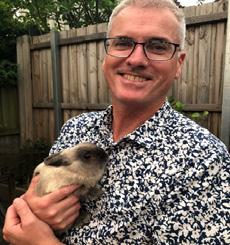
3 minute read
The Olympic Hoof Explained Peter Glimberg & Fran Jurga
THE OLYMPIC HOOF EXPLAINED
SWEDISH FARRIER OUTLINES BAREFOOT MANAGEMENT OF GOLD MEDAL SWEDISH EQUESTRIAN TEAM
Peter Glimberg Farrier, Grevlunda Training Center, Sweden
Following on from viewing Sweden’s top-class performances at Tokyo, Fran Jurga from Hoofcare Publishing interviewed notable Swedish Farrier Peter Glimberg on the use of barefoot farriery for elite horses. Peter Glimberg has been farrier for Peder Fredricson (Gold Team Medalist and Silver Medalist for Show Jumping at Tokyo) at the Grevlunda training center for three years and usually travels as the Swedish national team farrier, but this was not allowed at this Olympics. Below is a synopsis of Peter Glimberg’s personal comments to Fran Jurga that can be read in full at https://hoofcare.blogspot.com.
‘The hoofcare program for these top horses centers on the balance between the positive and the negative effects of both shod and unshod hooves. I believe that the unshod hoof interacts better with the modern fiber-sand arena surfaces, where these horses train and compete. The negative side of nailing a shoe to a hoof is that you automatically lift the hoof from the ground and therefore take away support from the underside of the frog and sole. Since modern arena materials are very firm, with a nailed-on steel or aluminium shoe, we also take away the hoof’s ability to flex medio/laterally. This is a problem because I think we therefore put excessive stress on the hoof, especially on the coffin joint, since the fiber-sand surfaces don’t allow one side to sink while turning.
Foot of a Swedish showjumper with a coating of epoxy resin to help reduce wear. Image © Peter Glimberg/ Hoofcare and Lameness.
Obviously, If the hoof wears down more than it grows, the horse will get sore. It is as simple as that. And then you will have to protect the hoof. At Grevlunda, they do use hoof boots while hacking out, but only then, not when training on fibresand surfaces.
Peter Glimberg devised a thin aluminum shoe, so that grass studs could be used. However, he later found that thin steel shoes were more successful. (Image © Peter Glimberg/
Hoofcare and Lameness) Quite often, I build up some extra hoof wall on these horses with a thin layer of epoxy material such as Vettec Superfast, so that the horses never get sore because of excessive wear. Sometimes they compete with the adhesive and sometimes they don’t. We use it when the horses need extra protection. The reason for putting this on is mainly for protection at areas surrounding the main arena. We have also tried really thin aluminium shoes for jumping at grass shows, just to be able to put studs in. These really thin hunter-fit type shoes allow the frog to function. However, I think we use far too thick standard shoes on show jumpers. I believe that horses can benefit from thinner shoes, just by getting closer to the ground and therefore getting better support from the surface. I believe that this program is something horsemen can benefit from if they have horses performing at the absolute top level. Otherwise, they are better off keeping their horses shod. I’m very proud of the Swedish riders in Tokyo and very proud to be a tiny bit part of it.’ My advice: “Keep it as close as you can to barefoot. The simplicity of a barefoot hoof interacting with a soft surface, that is what I believe in. But it is much, much easier said than done.”
Readers can subscribe to the Hoof Blog at https:// hoofcare.blogspot.com/ and perhaps of greater interest is subscription to Fran Jurga’s HoofSearch: The index of peer-reviewed equine foot research







